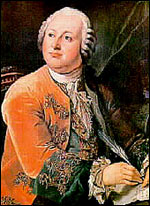 Mikhail
Lomonosov Mikhail
Lomonosov
Russia's first world-famed specialist in natural science,
a poet who laid down the foundations of Russian literary language
and an advocate of education,
Mikhail Vasilievich Lomonosov (1711-1765) will forever remain
in the history of Russian science as "the
first and the greatest."
Aspiring to get an education, Lomonosov left his native
village of Kholmogory in Northern Russia in 1730 and travelled
all the way to Moscow on foot.
The son of a poor fisherman, he had to conceal his origin
in order to be admitted to the Slavonic-Greek-Latin Academy
of Moscow, where he started his
education at the age of 19. Recognized by his instructors
as an excellent student, he completed his education in St.
Petersburg and in Germany.
|
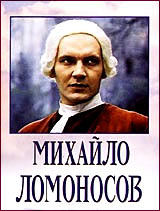 He
became the first Russian professor of chemistry at St. Petersburg
Academy of Science in 1745. His major scientific accomplishment
was in the field of physical chemistry, with other notable discoveries
in astronomy, geophysics, geology, metallurgy and mineralogy. He
became the first Russian professor of chemistry at St. Petersburg
Academy of Science in 1745. His major scientific accomplishment
was in the field of physical chemistry, with other notable discoveries
in astronomy, geophysics, geology, metallurgy and mineralogy.
Mikhail Lomonosov was the one who created a system of higher
education in Russia. The foundation of a university in Moscow
became possible only due to the efforts of M. Lomonosov, the
outstanding Russian scholar and scientist, a person of encyclopedic
knowledge. In 1940 on the occasion of its 185th Anniversary,
Moscow State University was named after him.
|
Interested in
furthering Russian education, Lomonosov wrote a grammar that
reformed the Russian literary language by combining Old Church
Slavonic with the vulgar tongue. He published the first history
of Russia in 1760 and invented a new system of meter in his
poetry, which consisted mostly of eloquent odes.
He also revived the art of Russian mosaic and built a
mosaic and colored-glass factory.
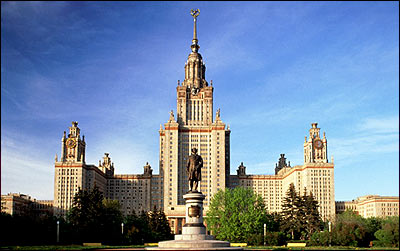
Lomonosov University in Moscow, statue
of Lomonosov in foreground.
Famous Russian poet Alexander
Pushkin was quite right when he wrote about the giant of
18th century world science: "Combining
the great will-power and the remarkable strength of perception,
Lomonosov embraced all the branches of learning. A thirst for
a deeper appreciation of things proved an overwhelming passion
with that impassioned spirit. A historian, mechanic, chemist,
physicist, astronomer, mining specialist, mineralogist, geographer,
historian, philologist, artist and poet, he had experienced
it all and perceived it all ...".
Even so, the vast scope of Lomonosov's interests and
the profundity of his knowledge appear amazing for that age.
He carried out researches and the scientific and technical projects
that were not simply enormous - they were immeasurable.
Lomonosov invented the first gas barometer, developed
the methods of exact weighting, brought up the kinetic theory
of warmth, developed the method of processing the colour glasses,
which he used for his great mosaics. Lomonosov proved the organic
origin of oils, stone coal and amber.
Lomonosov was the first Russian natural scientist of
world importance. He had encyclopedic knowledge, interests and
abilities, and he also is known as a poet, artist, astronomer
and Russian historian, who made important contributions to both
literature and science.
Most of his accomplishments, however, were unknown outside
Russia until long after his death in St. Petersburg on April
15, 1765.
|

|
Sofia Kovalevskaya
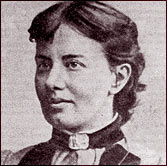 Sofia
Kovalevskaya (1850-1891) was destined to become a woman of great
strengths, and the contributions she made to mathematics promise
to be enduring ones. Sofia was attracted to mathematics at a
very young age. Sofia
Kovalevskaya (1850-1891) was destined to become a woman of great
strengths, and the contributions she made to mathematics promise
to be enduring ones. Sofia was attracted to mathematics at a
very young age.
When Sonya was 11, the walls of her nursery were papered with
pages of lecture notes on differential and integral analysis.
Studying the wallpaper was her introduction to calculus.
Sofia wrote in her autobiography:
"The meaning of these concepts
I naturally could not yet grasp, but they acted on my imagination,
instilling in me a reverence for mathematics as an exalted and
mysterious science which opens up to its initiates a new world
of wonders, inaccessible to ordinary mortals."
|
|
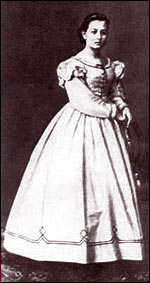 Sofia
was forced to marry so that she could go abroad to study.
Her father would not allow her to leave home to study
at a university, and women in Russia could not live apart
from their families without the written permission of their
father or husband. At the age of eighteen, she entered a nominal
marriage with Vladimir Kovalevski, a young palaeontologist. Sofia
was forced to marry so that she could go abroad to study.
Her father would not allow her to leave home to study
at a university, and women in Russia could not live apart
from their families without the written permission of their
father or husband. At the age of eighteen, she entered a nominal
marriage with Vladimir Kovalevski, a young palaeontologist.
In 1869 Sofia travelled to Heidelberg to study mathematics
and the natural sciences, only to discover that women could
not matriculate at the university. Eventually she persuaded
the university authorities to allow her to attend lectures
unofficially, provided that she obtain the permission of each
of her lecturers. Professors considered her a gifted student
and spoke about her as an extraordinary phenomenon .
By the spring of 1874, Kovalevskaya had completed
three papers, each of these worthy of a doctorate. The three
papers were on Partial differential equations, Abelian integrals
and Saturn's Rings.
In 1882 she began work on the refraction of light.
She began to lecture there in early 1884, was appointed to
a five year extraordinary professorship in June of that year,
and in June 1889 became the first woman since the physicist
Laura Bassi and Maria Gaetana Agnesi to hold a chair at a
European university.
Although the Tsarist government had repeatedly refused
her a university position in her own country, the rules at
the Imperial Academy were changed to allow the election of
a woman.
Sonya Kovalevsky has been described as the brightest
star among all female mathematicians analysis is a permanent
monument to her greatness. The Cauchy-Kovalevsky Theorem is
at the foundation of most graduate courses in partial differential
equations.
Her novel The Sisters Rajevski (based upon her own
childhood) is a superb account of life among the intellectuals
at a crucial period in Russian history.
In early 1891, at the height of her mathematical powers
and reputation, Kovalevskaya died of influenza complicated
by pneumonia.
|

|
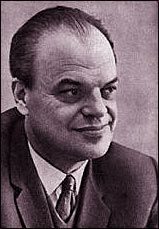 Nikolai
Basov Nikolai
Basov
Nikolai Basov (1922 - 2001) is a Russian physicist whose pioneering
work led to the invention of the laser.
Basov shared the 1964 Nobel Prize for Physics with Alexander
Prokhorov and Charles Townes for fundamental research into quantum
electronics, which forms the foundation on which modern laser
technology stands.
After four years of military service during the Second
World War, Basov studied physics at the Moscow
Institute of Physical Engineers.
In 1948 he moved to the Lebedev Physical Institute,
also in Moscow, where he worked under the supervision of Prokhorov.
While the pair were searching for a technique to amplify microwave
signals in spectroscopic experiments, they hit upon the idea
of using a gas-filled cavity with reflectors at either end,
in which the microwave beam would be intensified. Their discovery
that this method produced microwaves with an extremely narrow
range of frequencies led to the construction of a 'maser'
- microwave amplification by stimulated emission of radiation
- and, after further refinements, the laser. Working in the
US, Townes simultaneously made the same breakthrough.
Basov later became a professor in the department of
solid-state physics at the Moscow Institute of Physical Engineers.
He was also appointed as vice-director of at the P N Lebedev
Physical Institute in 1958, where he became director in 1973.
He achieved further recognition in Soviet political life,
serving in the Presidium from 1982 until 1989. Basov was a
head of the laboratory of quantum radiophysics at the Lebedev
institute at the time of his death at the age of 78.
|

|
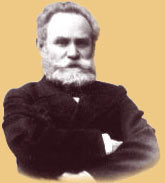 Ivan
Pavlov Ivan
Pavlov
Academician Ivan Pavlov (1854 - 1929) is the first Russian Nobel
Prize winner in the Theoretical Medicine, the Honorable
Doctor of the Cambridge University, member of 132 academies
and societies, the first physiologist of the world. The scientific
activity of Pavlov lasted for more than six decades. His name
is connected with the most remarkable discoveries in the sphere
of blood circulation physiology, digestion and central nervous
system.
He developed investigations in the field of physiology
and pathology of the human and animal higher nervous activity,
cortico-visceral interrelations, neurogenetics, evolutionary
and comparative physiology. Studies on physiology of the sensory
and visceral systems were developed intensively. An important
aspect of the performed investigations was analysis of the
regulatory effect of the nervous system upon the organism
functional systems and processes of their autoregulation.
Pavlov Institute of Physiology of the Russian Academy
of Science was founded in 1925 by Ivan Pavlov. Under his guidance,
in 1925-1936, problems ofphysiology, pathology, and genetics
of the higher nervous activity were intensively investigated.
In 1930s-1990s, directors of the Institute were prominent researchers
and organizers of science, members of the USSR Academy of Sciences.
At present, more than 300 researchers have been working
at the Institute. Pavlov Institute of Physiology of the Russian
Academy of Sciences is the largest multiprofile physiological
institution of the country.

|
|
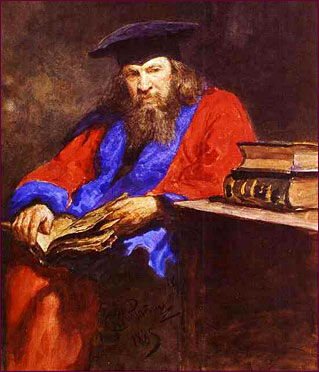
Ilya Repin. Portrait of Dmitry
Mendeleev. 1885. Watercolour on paper. The Tretyakov Gallery,
Moscow. |

|
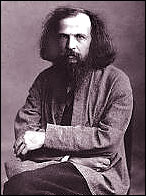 Dmitri
Mendeleev Dmitri
Mendeleev
Dmitri Mendeleev (1834-1907) is a famous Russian chemist who
arranged the 63 known elements into a periodic table based on
atomic mass, which he published in Principles of Chemistry
in 1869.
According to Mendeleev it took him 20 years to invent this
system. During the time when the system was being invented
atomic weights of many elements had been defined wrongly, forms
of their compounds were imperfect, many elements had not been
studied yet and as the result of all this there was a serious
confusion in correlation between atomic weights and elements
characteristics. Actually this invented periodical system was
just one of many systems built basing on atomic weight.
The wonderful legend says that Mendeleev invented the
periodical system in his dream and this story is bases on a
real fact told by Inostrantsev. Once Inostrantsev came
to Mendeleev's private office and saw that Mendeleev was in
a very gloomy mood. Mendeleev complained that he was thinking
about the system and he almost got it in his mind but couldn't
express in a table. Three days later he was still working at
his favourite table in his office without having a rest for
three nights trying to compile a table. Nothing helped so at
the end he was very exhausted and fell asleep. In his dream
he saw the table of elements very clear and when he woke up
he wrote down everything he had seen and only one small correction
was made afterwards.
|
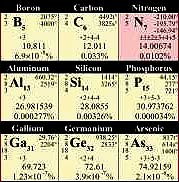 From
his remarkable table Mendeleev predicted the properties of elements
then unknown; three of these (gallium, scandium, and germanium)
were later discovered. He studied also the nature of solutions
and the expansion of liquids. An outstanding teacher, he was
professor at the Univ. of St. Petersburg (1868–90). He
directed the bureau of weights and measures from 1893 and served
as government adviser on the development of the petroleum industry.
His Principles of Chemistry (2 vol., 1868–71; tr. 1905)
was long a standard text. From
his remarkable table Mendeleev predicted the properties of elements
then unknown; three of these (gallium, scandium, and germanium)
were later discovered. He studied also the nature of solutions
and the expansion of liquids. An outstanding teacher, he was
professor at the Univ. of St. Petersburg (1868–90). He
directed the bureau of weights and measures from 1893 and served
as government adviser on the development of the petroleum industry.
His Principles of Chemistry (2 vol., 1868–71; tr. 1905)
was long a standard text.
The formula of 40° vodka was also discovered by Mendeleev.
It is known that the British started doing alcoholometric
research at the 18th century and some other scientists from
different countries were also doing weight analysis of alcoholic
solutions.
While they used to mix water and spirit basing on volumes
Mendeleev tried to mix them by weight, which was more difficult
and give more accurate results. It turned out that the ideal
content of spirit in vodka should be 40° , the figure that
you can only get if you mix precise weights not by mixing volumes.
Largest compression of mixture can be reached upon reciprocal
dilution of weights: 45.88% of anhydrous spirit with 54.12%
of water. It means that if there are three water molecules for
one spirit molecule then the volume of mixture is minimal and
therefore specific proportion is reaches maximum. Thus, 1 litre
of 40° vodka shall weight 951 grams exactly.
Mendeleev wrote a formula of 30 components in 5 rows.
He thought his formula was very simple but the result of this
formula was so precise that it exceeded all results of researches
of his predecessors.
One reason that no adequate biography of Mendeleev has
yet been written is that he was as active in politics and social
issues as he was in chemistry. The future biographer faces a
mountain of archival material, most of it collected in the Mendeleev
Museum in St. Petersburg.
|

|
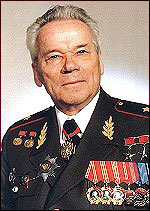 Mikhail
Kalashnikov Mikhail
Kalashnikov
Kalashnikov was born on November 10, 1919, in the
village of Kurya, Altai Territory, to a large peasant family.
In 1938 he entered the Red Army in Kiev where he attended
tank mechanics school. In the army, he designed a device to
count the number of shots fired by a tank as well as other useful
tactical devices for tanks.
|
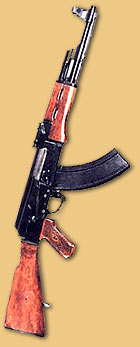 After
surviving fierce battles against the Nazi's in 1941 as a tank
commander, he found himself in hospital recovering from serious
wounds. Here at the hospital he began to conceive ideas for
a new machine gun which could provide high volume, light weight
firepower for soldiers. In 1944 his first prototype was adopted
for further development and finally in 1949 the soviet army
adopted the Automatic Kalashnikov design of 1947 as their standard
rifle. After
surviving fierce battles against the Nazi's in 1941 as a tank
commander, he found himself in hospital recovering from serious
wounds. Here at the hospital he began to conceive ideas for
a new machine gun which could provide high volume, light weight
firepower for soldiers. In 1944 his first prototype was adopted
for further development and finally in 1949 the soviet army
adopted the Automatic Kalashnikov design of 1947 as their standard
rifle.
The submachine guns of Kalashnikov system are widespread
all over the world. Some countries have included its image in
the State Emblem.
More than 50 armies of the world have in their arsenals firearms
created by Mikhail Kalashnikov.
By 1990 there were made about 70 millions units of Kalashnikov
submachine guns of various modifications both in Russia and
abroad including those made under license and piratically
(till nowadays the invention has not been patented).
The cause of such great popularity of Kalashnikov submachine
guns is in the fact that Kalashnikov has achieved an optimum
combination of a number of qualities which provide the usage
of guns with high efficiency of application and exclusive reliability
in battles.
The President of Russia Boris Eltsin personally decorated
the outstanding designer M. T. Kalashnikov with the Order "For
Distinguished Services for the Motherland" Second Class
and promoted him to Major-General to his 75th anniversary. |

|
Alexander
Popov
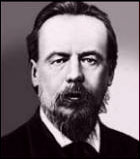 Russian
people will always remember their great scientist Alexander
Popov (1859-1905) who invented radio. Russian
people will always remember their great scientist Alexander
Popov (1859-1905) who invented radio.
In 1895 he developed the first radio-receiver that could
register thunderstorm electricity discharge from considerable
distances.
|
|
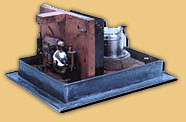 On
12th of March 1896 Popov together with Ribkin demonstrated
wireless transmission of Morse signals from one university
building to another that was 200 meters far from the first
one. It was the first sensible transmission of text in the
world. In spring of 1897 Popov conducted some experiments
on the ships and was able to transmit information to a ship
that was as far as 640 meters from Popov. He was increasing
the distance of transmission day by day. On
12th of March 1896 Popov together with Ribkin demonstrated
wireless transmission of Morse signals from one university
building to another that was 200 meters far from the first
one. It was the first sensible transmission of text in the
world. In spring of 1897 Popov conducted some experiments
on the ships and was able to transmit information to a ship
that was as far as 640 meters from Popov. He was increasing
the distance of transmission day by day.
In 1897 he also discovered that all metal objects in
the way of a radio wave could change the wave direction, or
in other words could reflect it. It was the start of another
useful invention called later radio-location. Imperfection
of equipment at that time did not allow to put the observation
into use until 40 years later when the first radio-radar was
built. Others have laid claims that they discovered this phenomena
of wave reflection, but it should be remembered that the invention
was actually made by Popov.
|

|
Links
About Lomonosov: www.litera.ru,
www.alhimik.ru,
www.rusnauka.narod.ru,
Lomonosov University official
website (in Russian).
Nikolai
Basov Biography, Ivan
Pavlov Biography, about Sofia
Kovalevskaya, interview
with Valentina Ttereshkova, V.
Tereshkova's biography, U.
Gagarin's biography, Uri Gagarin - life
in pictures.
About
Mikhail Kalashnikov, about
Alexander Popov. |
|



